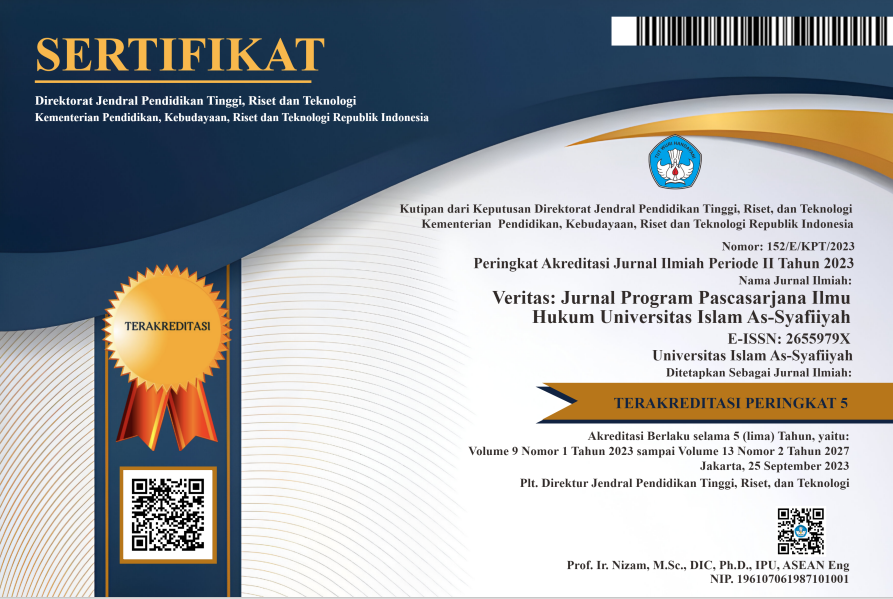TEORI LABELLING DAN PENGARUHNYA TERHADAP KEDUDUKAN MANTAN NARAPIDANA DALAM BERMASYARAKAT
Abstract
Crime is perceived to affect Culture in Indonesia, the number of crimes will worsen
the image of Indonesia in the eyes of the world, and eventually Indonesia will be
known as the country with the highest crime rate. This is certainly not an
achievement for a democratic unitary state, so the need to eradicate every crime
and to seek the cause of the occurrence of a crime, because one commits a crime,
until the reason for the crime occurs, so the role and function of the Criminology
Science. This study uses the Juridical Empirical approach, which is a study that
emphasizes the real life of the community in Karawang regency, so any research
that based or conceptualize the law as behavior or behavior and community action
can be referred to as social research (law), empirical or research the nondoctrinal.
Plunge directly in the life of the community, making observations and
interviews is one of the techniques taken in collecting any data required. One of the
studies that became the center of his research is Labeling Theory which is part of
the supporting theories of Criminology. Labeling itself is a theory that studies
about the reaction of a label attached to a thing or living creature. A person who
can not accept the label attached to him will most probably do abnormal actions,
such as violence or even criminal crimes. Not infrequently the element of labeling
is the reason for the repetition of a criminal act (Residivist).
References
A. Sumber Buku
Adang. Yesmil Anwar. 2013. Kriminologi. PT Refika Aditama. Bandung.
Arief. Barda Nawawi. 2014. Masalah Penegakkan Hukum dan Kebijakan Hukum
Pidana dalam Penanggulangan Kejahatan. Kencana. Jakarta.
---------------------------. 2009. Tujuan dan Pedoman Pemidanaan. Badan Penerbit
Universitas Diponegoro. Semarang.
---------------------------. 2010. Kebijakan Legislative dalam Penanggulangan
Kejahatan Dengan Pidana Penjara. Genta Publishing. Yogyakarta.
Ashshofa, Burhan. 2013. Metode Penelitian Hukum. PT Rineka Cipta. Jakarta
Candra Irawan. 2013, Dasar – Dasar Pemikiran Hukum Ekonomi Indonesia,
Mandar Maju. Bandung.
Effendi. Masyur dkk. 2014. HAM dalam Dinamika/Dimensi Hukum, Politik,
Ekonomi dan Social. Ghalia Indonesia. Bogor.
Hagan. Frank E. 2013. Pengantar Kriminologi, Teori, Metode, dan Perilaku
Criminal. Kencana. Jakarta
Jeemy bentham, 2006. Teori Perundang – undangan Prinsip Legislasi Hukum
Perdata dan Pidana (Terjemahan Indonesia oleh Nurhadi), Bandung.
Jones, Pengantar Teori – Teori Sosial Dari Teori Fungsionalisme Hingga Post-
Modernisme, Jakarta : Yayasan Pustaka Obor Indonesia, 2003.
Mustofa. Muhammad. 2015. Metodologi Penelitian Kriminologi. Prenadamedia
Group. Jakarta.
Nitibaskara. Tb. Ronny Rahman. 2009. Perangkap Penyimpangan dan Kejahatan,
Teori Baru dalam Kriminologi. Yayasan Pengembangan Kajian ilmu
Kepolisian. Jakarta.
Rahayu. 2010. Hukum Hak Asasi Manusia (HAM). Badan Penerbit Universitas
Diponogoro. Semarang.
Saebani. Beni Ahmad. 2009. Metode Penelitian Hukum. CV Pustaka Setia.
Bandung.
Salim. Agus. 2006. Teori dan Paradigma Penelitian Sosial. Tiara Wacana.
Yogyakarta.
Soekanto, Soerjano. 2015. Pengantar Penelitian Hukum. Universitas Indonesia.
Jakarta.
Warssih. Esmi dkk. 2016. Penelitian Hukum Inter Disipliner. Thafa Media.
Yogyakarta.
Wiradipradja. E. Saefullah. 2015. Penuntun Praktis Penelitian dan Penulisan
Karya Ilmiah Hukum. CV Keni Media. Bandung.
B. Sumber Undang – Undang
Undang – undang Nomor 12 tahun 1995 tentang Pemasyarakatan
C. Sumber Lain – Lain
http://Blog, my words, teori labelling dalam kriminologi, trisna widyaningtyas, 10
desember 2016.
http://BLOG.MyWords.com/Teori-Labelling-dalam-Kriminologi/Trisna-
Widyaningtyas/10 Desember 2016.
http://inulwara.blogspot.com/Asas–asas-Hak-Asasi-Manusia/01/2014/26
November 2016
http://Kompas.com/Mirna-jesika/23/september/2016/16.00Wib
http://MyWords.blogspot.com/Teori-Labelling-dalam-Kriminologi/Trisna-
Widyaningtyas/10/Desember/2016
http://BadanPusatStatistik.com/indekskejahatan/19/12/2016/20.00




